BioSensics PM002 Activity Monitor User Manual PAMWare final
BioSensics LLC Activity Monitor PAMWare final
User Manual.pdf
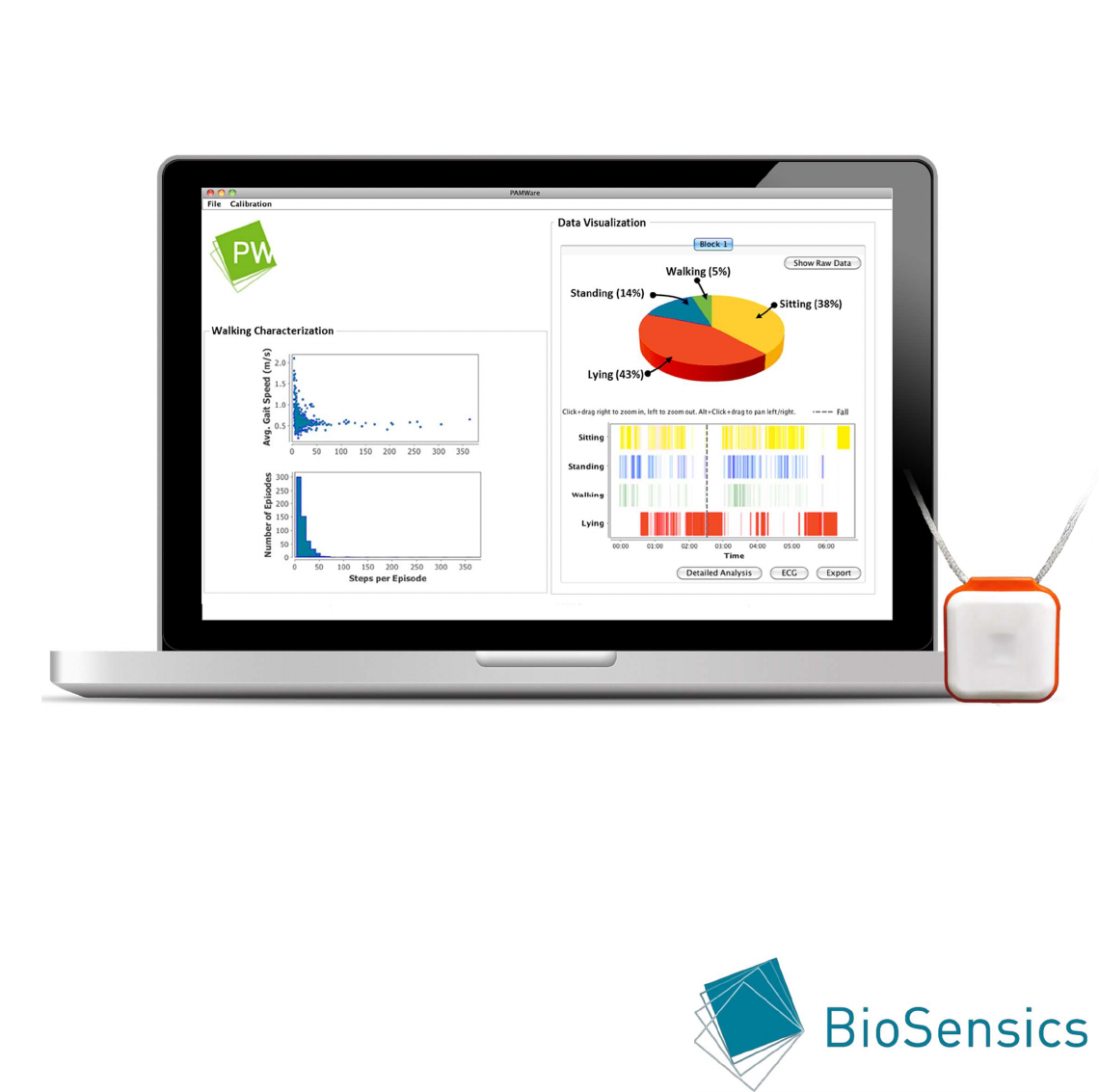
PAMSysTM User’s Manual
© 2017 BioSensics LLC
January 1st, 2017
Version 2.0

Table of Contents
PAMSys User’s Manual V2.0
2
Table of Contents
Welcome to PAMSys........................................................................................................................... 3
Introduction ........................................................................................................................................ 3
Intended Use ..................................................................................................................................... 3
Components of Your System ............................................................................................................. 3
PAMSys Options ............................................................................................................................... 4
Additional Accessories ...................................................................................................................... 4
Safety Instructions ............................................................................................................................. 4
FCC Compliance Information ............................................................................................................ 5
Getting Started .................................................................................................................................... 6
Software Installation .......................................................................................................................... 6
Getting to Know Your Motion Sensors ............................................................................................... 6
Charging ............................................................................................................................................ 7
Storage and Maintenance ................................................................................................................. 7
Data Collection .................................................................................................................................... 8
Sensor Placement (on the body) ....................................................................................................... 8
Recording Data with PAMSys ........................................................................................................... 9
Data Transfer ............................................................................................................................. 10-11
Data Analysis .................................................................................................................................... 12
Loading Data ................................................................................................................................... 12
Analyzing Data ................................................................................................................................ 13
Interpreting Analyzed Data ......................................................................................................... 13-15
Exporting Data ................................................................................................................................. 15
Specifications .................................................................................................................................... 16
Additional Resources and Support ................................................................................................. 17
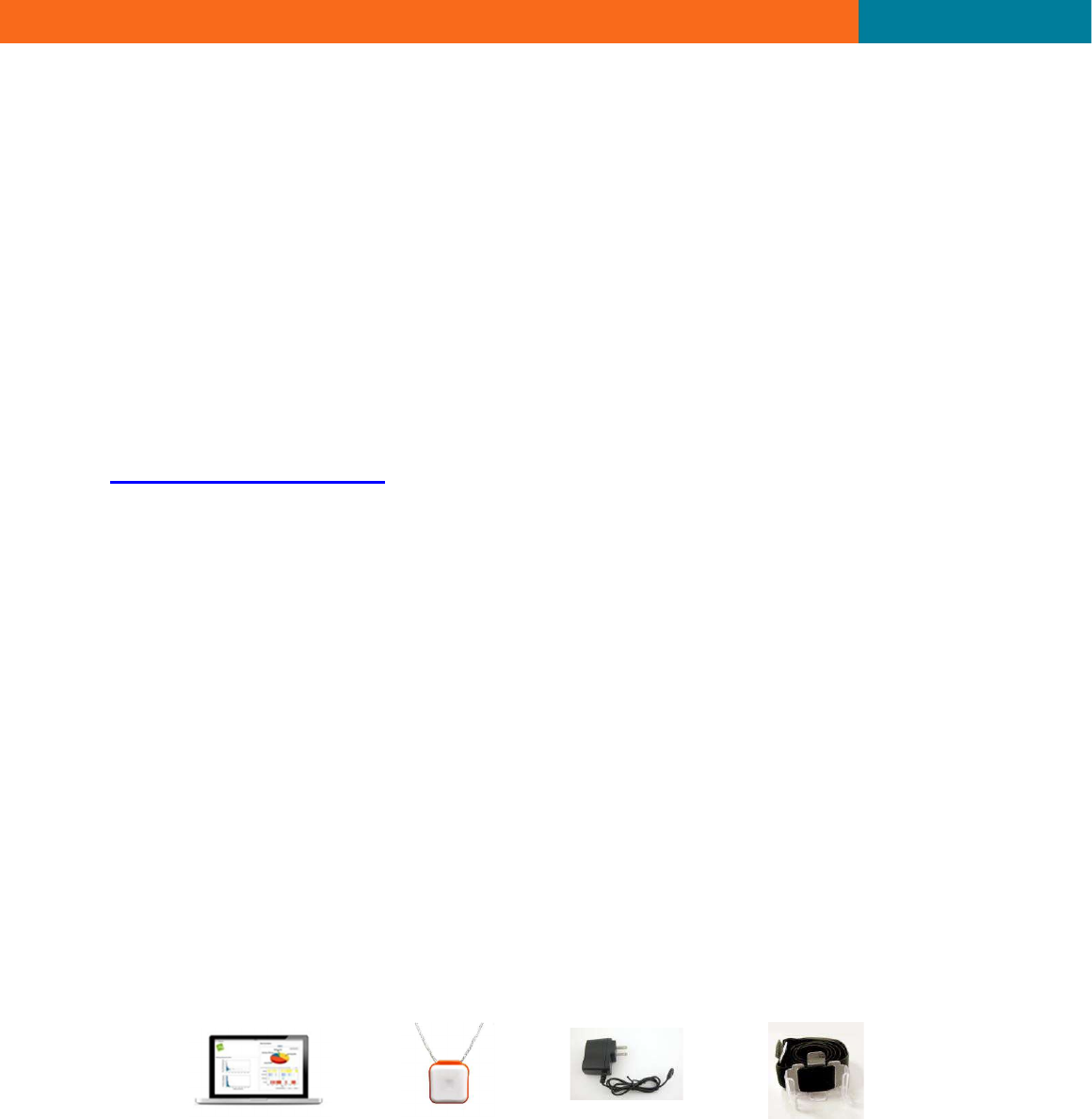
Introduction
PAMSys User’s Manual V2.0
3
Welcome to PAMSys
Introduction
Thank you for purchasing PAMSys. PAMSys uses advance signal processing algorithms and novel
biomechanical models of human motion to identify a complete physical activity map of the user from
data measured by a single, lightweight, wearable motion sensor. This User’s Manual will help you
familiarize yourself with PAMSys and get you up and running in no time. Should you have any
questions, help and support are available from 9am to 5pm Monday through Friday (Eastern
Standard Time).
E- mail: support@biosensics.com
Telephone: 1-888-589-6213
Intended Use
PAMSys is intended for long-term monitoring of posture (sitting, standing, walking or lying down),
postural transitions (duration and time of occurrence), gait (duration, number of steps, cadence and
step time variability) and falls (number of falls and time of occurrence). PAMSys is neither offered,
marketed nor intended for use as a medical device, as defined by the Food and Drug Administration.
PAMSys is intended and marketed solely for use in research settings.
Components of Your System
PAMSys consists of a wearable motion sensor with strap, software, and a charging unit for the
sensor. The included Windows-compatible software, PAMWare, is used to visualize data collected
with your sensor.
Pamware
Sensor
Charging Unit
Chest Strap

Introduction
PAMSys User’s Manual V2.0
4
PAMSys Options
BioSensics offers the following variations of PAMSys:
PAMSys-X™: Synchronized monitoring of multiple body segment movements.
PAMSys-ECG™: Synchronized long-term co-monitoring of physical activity, heart rate and heart rate
variability using a 3-lead electrocardiogram.
PAMSys with GPS: Synchronized monitoring of physical activity and GPS signal.
PAMSys with Gyroscope: Synchronized monitoring of physical activity and continuous tri-axial
accelerometer and tri-axial gyroscope data.
Additional Accessories
PAMShirt™: A customized cotton t-shirt with a pocket for the PAMSys sensor.
Multi-Unit Charger: Charge up to 7 PAMSys sensors simultaneously. Included free with orders of 5 or
more PAMSys sensors.
Contact us at 1-888-589-6213 or sales@biosensics.com (M-F 9am to 5pm EST) for more information
about PAMSys Options or additional accessories.
Safety Instructions
Make sure you have read and understood all the information listed in this document prior to using
PAMSys. If you require additional information and/or training, please contact customer service.
•
If motion sensors are used among numerous individuals and placed directly onto the patient
(instead of over clothing) they should be cleaned and disinfected in an appropriate manner
prior to use. PAMSys sensors can be cleaned using an alcohol swab.
•
Ensure that motion sensor straps are not cutting off blood flow.
•
BioSensics motion sensors should be charged only using the charger provided with your
purchase.
Warning: The PAMSys sensor contains a lithium polymer battery. Please follow local regulations
regarding disposal or recycling of lithium-containing electronics. Do not throw the device away in the
trash.

Introduction
PAMSys User’s Manual V2.0
5
FCC Compliance Information
Changes or modifications not expressly approved by BioSensics, LLC could void the user’s authority
to operate the equipment.
This device complies with Part 15 of the FCC Rules. Operation is subject to the following two
conditions: (1) this device may not cause harmful interference, and (2) this device must accept any
interference received, including interference that may cause undesired operation.
This equipment has been tested and found to comply with the limits for a Class B digital device,
pursuant to Part 15 of the FCC Rules. These limits are designed to provide reasonable protection
against harmful interference in a residential installation. This equipment generates, uses and can
radiate radio frequency energy and, if not installed and used in accordance with the instructions, may
cause harmful interference to radio communications. However, there is no guarantee that
interference will not occur in a particular installation. If this equipment does cause harmful
interference to radio or television reception, which can be determined by turning the equipment off
and on, the user is encouraged to try to correct the interference by one of the following measures:
-- Reorient or relocate the receiving antenna.
-- Increase the separation between the equipment and receiver.
-- Connect the equipment into an outlet on a circuit different from that to which the receiver is
connected.
-- Consult the dealer or an experienced radio/TV technician for help.
WARNING!
FCC and IC Exposure Statement
This portable equipment with its antenna complies with FCC’s RF radiation exposure limits set forth for
an uncontrolled environment. To maintain compliance follow the instructions below:
1. This transmitter must not be co-located or operating in conjunction with any other antenna or
transmitter.
2. Avoid direct contact to the antenna, or keep contact to a minimum while using this equipment.
Industry Canada
This device complies with Industry Canada licence-exempt RSS standard(s). Operation is subject to
the following two conditions: (1) this device may not cause interference, and (2) this device must
accept any interference, including interference that may cause undesired operation of the device.
Le présent appareil est conforme aux CNR d'Industrie Canada applicables aux appareils radio exempts
de licence. L'exploitation est autorisée aux deux conditions suivantes : (1) l'appareil ne doit pas
produire de brouillage, et (2) l'appareil doit accepter tout brouillage radioélectrique subi, même si le
brouillage est susceptible d'en compromettre le fonctionnement.
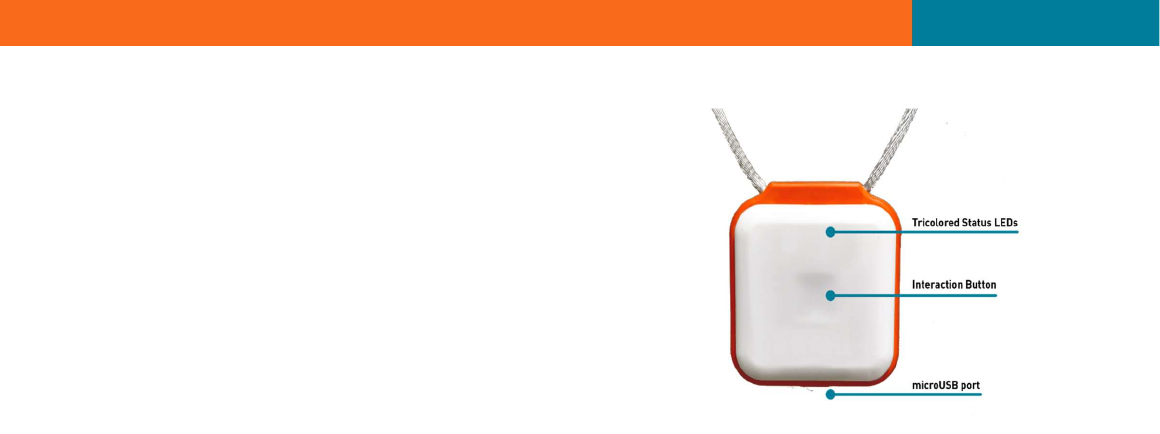
PAMSys User’s Manual V2.0
6
Getting Started
Getting Started
Software Installation
At this time, PAMWare is only available for Windows.
1.
Download the installation files from the link or CD
provided to you.
2.
If you have a 32-bit version of Windows, double click
PAMWareInstaller v1.x.x 32Bit.exe to run the
PAMWare Installer. If you have a 64-bit version of
Windows, double click PAMWareInstaller v1.x.x 64Bit.exe to run the PAMWare Installer.
To determine your system type (in Windows 10), search for ‘System and Security’ in your computer’s
Control Panel and click ‘System' to view detailed system information. For earlier versions of Windows
please consult your computer's user manual.
Getting to Know Your Motion Sensors
BioSensics Motion Sensors should be attached to the body with the top surface (with the BioSensics
logo) facing away from the body. The Reset/Power button is used to power-on, power-off or start a
new measurement and is recessed from the surface by design.
If the sensor is off, pressing the button turns on the sensor and starts a new measurement.
If the unit is on, pressing the button briefly will start a new measurement and will create a new
folder on the embedded MicroSD card.
If the unit is on, pressing the button for 5 seconds or longer will power off the sensor.
The tri-colored status LED (Green, Orange and Red) shows the condition of the PAMSys motion
sensor. A steady green light indicates the start of a new measurement. The LED will blink green
every 3 seconds during a measurement. A solid orange light indicates low battery power and will turn
red when battery power is too low to record data any further. When the sensor is charging, the LED
will be solid orange. When the sensor is fully charged, the LED will be solid green.

PAMSys User’s Manual V2.0
7
Getting Started
Charging
Each PAMSys motion sensor is equipped with a rechargeable lithium battery. The sensor’s battery
life is approximately 7 days. When recharging, please use only the supplied charging unit.
If the sensor unit is powered off the units will still be charging. If the sensor unit is powered on, the
charger indicator will light up, indicating that the sensor unit has been correctly plugged in. During
recharging, the charger indicator is steady orange. When the battery is fully charged, the charger
indicator turns steady green.
The normal charge time is about 2.5 hours. For a highly-depleted battery, a longer recharge and
battery conditioning period might be needed.
Storage and Maintenance
BioSensics Motion Sensors should be stored in a cool dry place. Motion sensors should be fully
charged prior to storage to maximize battery lifetime. If BioSensics motion sensors become dirty they
can be cleaned using an alcohol swab. During cleaning be careful not to allow moisture into the
external docking port.
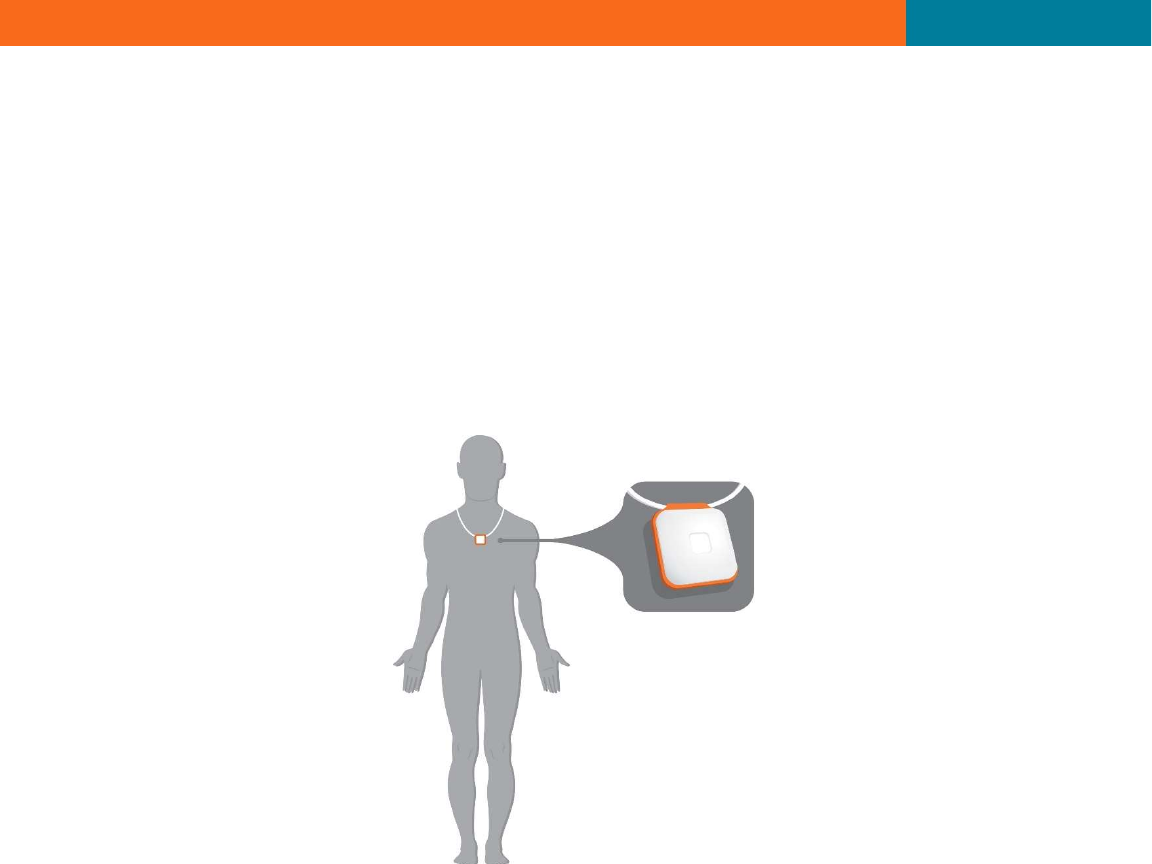
PAMSys User’s Manual V2.0
8
Data Collection
Data Collection
Sensor Placement (on the body)
Single sensor configuration
The PAMSys motion sensor can be affixed to the body with either the provided chest strap or a
PAMSys shirt (sold separately). BioSensics recommends placing the motion sensor in the chest strap
or PAMSys shirt the same way each time it is worn; preferably with the PAMSys logo facing forward
and the arrow pointing to the person’s left (see picture below).
Multi-sensor configuration (PAMSys-X)
The PAMSys-X system consists of 5 sensors to be used with 5 Velcro straps (one chest strap, two
small straps for each wrist and two large straps for each leg). Each sensor is labeled with a body
assignment. BioSensics recommends placing the motion sensor in the chest strap the same way
each time it is worn; preferably with the PAMSys logo facing forward and the arrow pointing to the
person’s left (see picture above). To attach the wrist and leg sensors, Move the thin band to the side
and out of the way of the opening. Slide the appropriately marked sensor (logo side facing up) into
the sleeve then move the thin band over the sensor to secure it in place. Fasten the Velcro strap to
the body so that the sensor’s charging port is facing away from the hands and feet. Repeat these
steps for each WRIST and LEG sensor.

PAMSys User’s Manual V2.0
9
Data Collection
For PAMSys-X, the multi-sensor configuration must first be synchronized before beginning to
record data. Press the Reset/Power button on the front face to power each of the five sensors, with
the CHEST sensor being turned on last. The LED will quickly blink orange when the sensor is on.
Once all the sensors are on, the CHEST sensor briefly shows a red light, then they will attempt to
sync amongst each other. The sensors are successfully synced when the CHEST sensor blinks
orange independently, and slightly before, the WRIST and LEG sensors, which will blink orange
simultaneously. This sequence will occur every three seconds.
Recording Data with PAMSys
To begin recording data, turn the sensor on by pressing the reset/power button. Next, the user should
stand up and place the sensor on the body using the chest strap or PAMSys shirt as directed above.
If using the PAMSys-X system please synchronize the sensors before beginning to record data. The
user must stand in place for at least 10 seconds. After this period of time, the sensor is now ready to
collect and record physical activity data. The time when a new measurement is started and when
the subject is standing still and upright should be noted. These times will be used in
PAMWare to properly analyze the data (see ‘Data Analysis’).
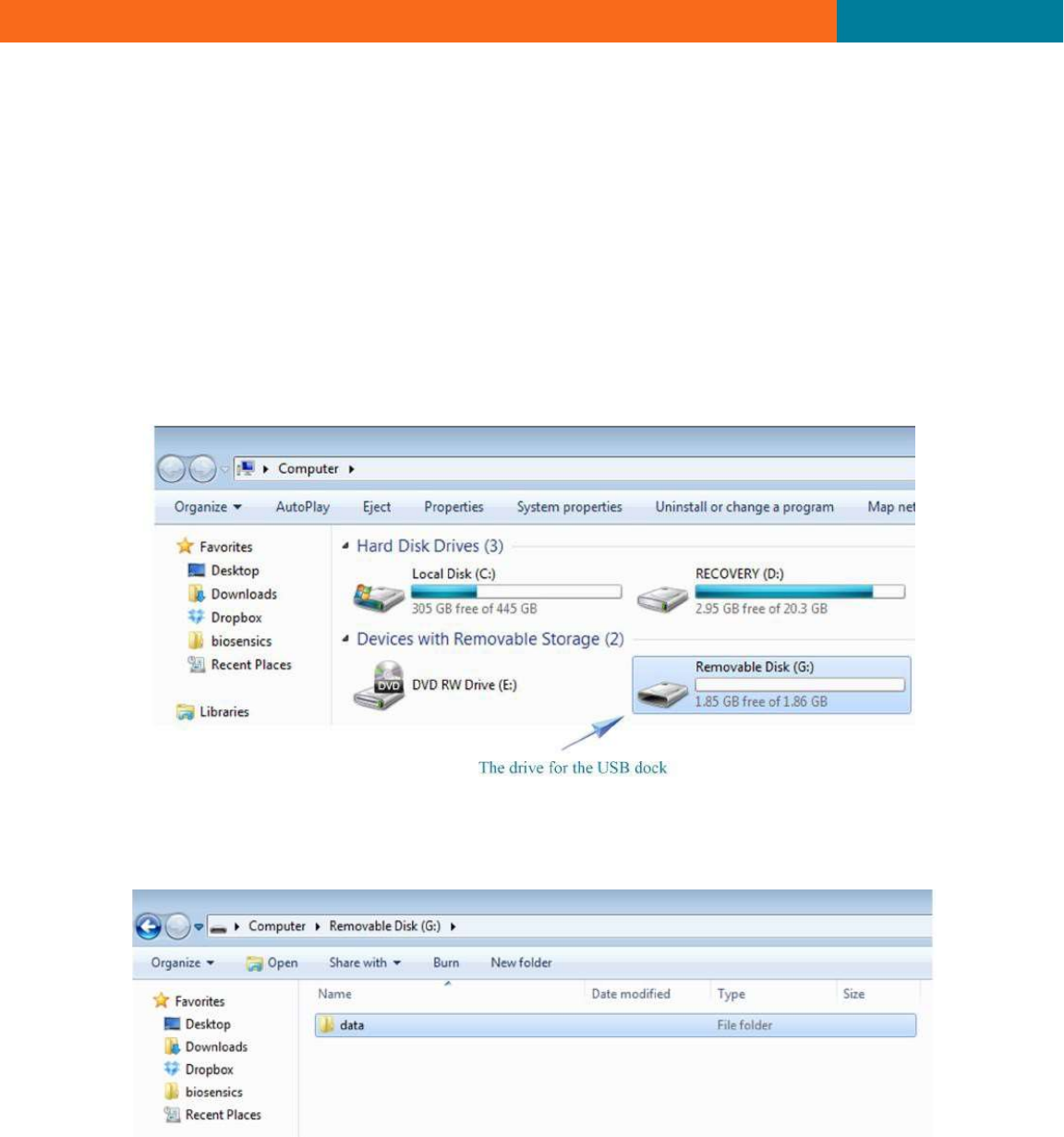
PAMSys User’s Manual V2.0
10
Data Collection
Data Transfer
Recorded data is transferred to a computer using the USB cable provided with each purchase of
PAMWare. First, connect the sensor to the computer using the USB cable. After plugging in the
sensor for the first time, the appropriate software drivers will be automatically installed.
After the sensor is connected, the measured data can be accessed by clicking on the drive letter
associated with the USB (G: in the example shown here) under the ‘My Computer’ folder, and the
contents of the embedded flash memory card may be browsed. Note that the PAMSys motion sensor
must be powered on to access the stored data.
All data measured by the PAMSys motion sensor is stored in the folder named ‘data,’ as shown
below.
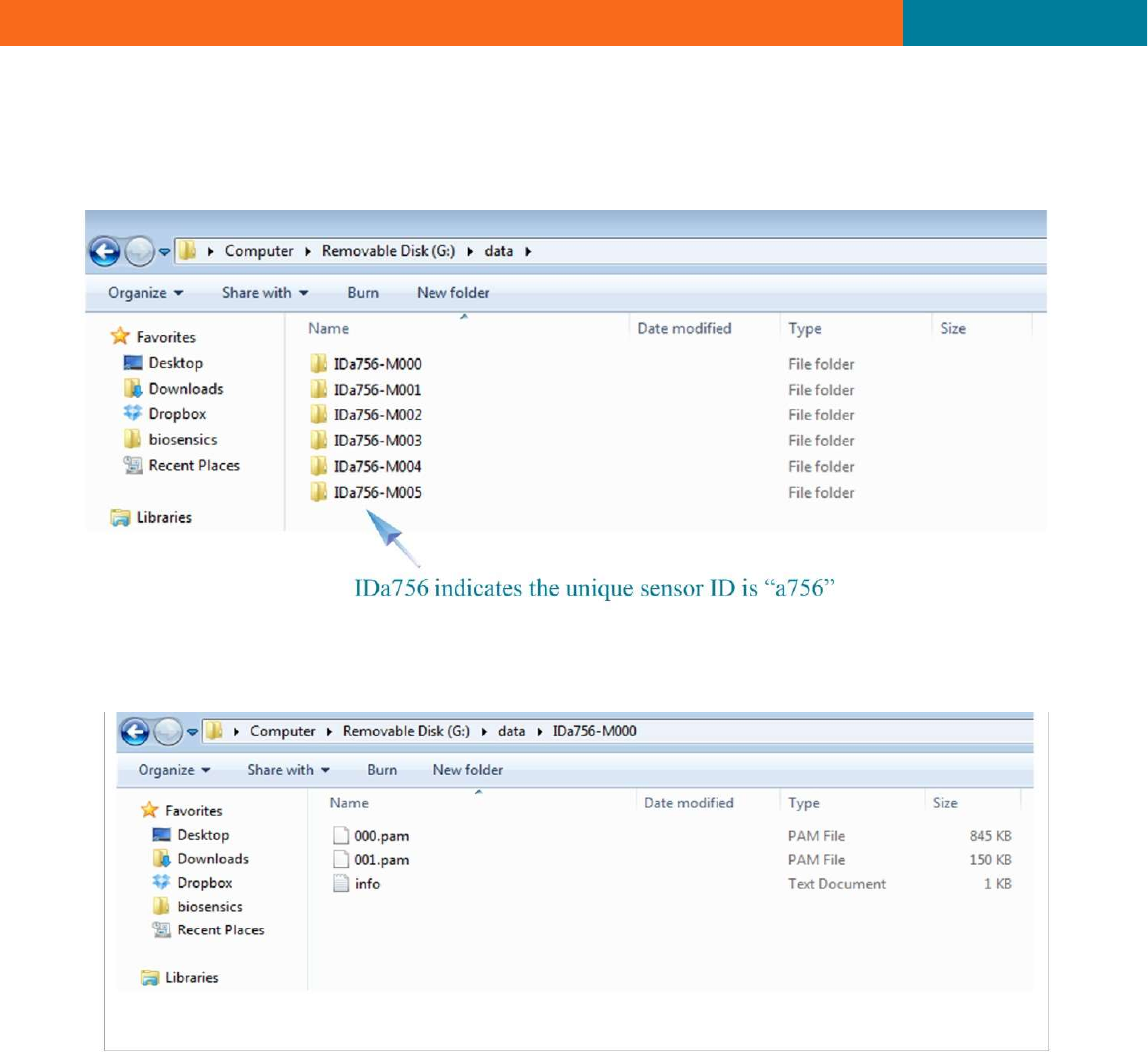
PAMSys User’s Manual V2.0
11
Data Collection
After clicking on this folder, each subfolder corresponds to one measurement. The subfolders are
named automatically according to the following convention: ‘IDxxxx-Myyy’, where ‘xxxx’ is the unique
ID of the PAMSys motion sensor and ‘yyy’ is the measurement number.
Within each subfolder, each file contains an hour-long segment of the recorded data.
The measured data can be analyzed and plotted using the PAMWare. For easy access, copy the
entire subfolder (‘IDxxxx-Myyy’) to your PC; do not just copy the .pam files.
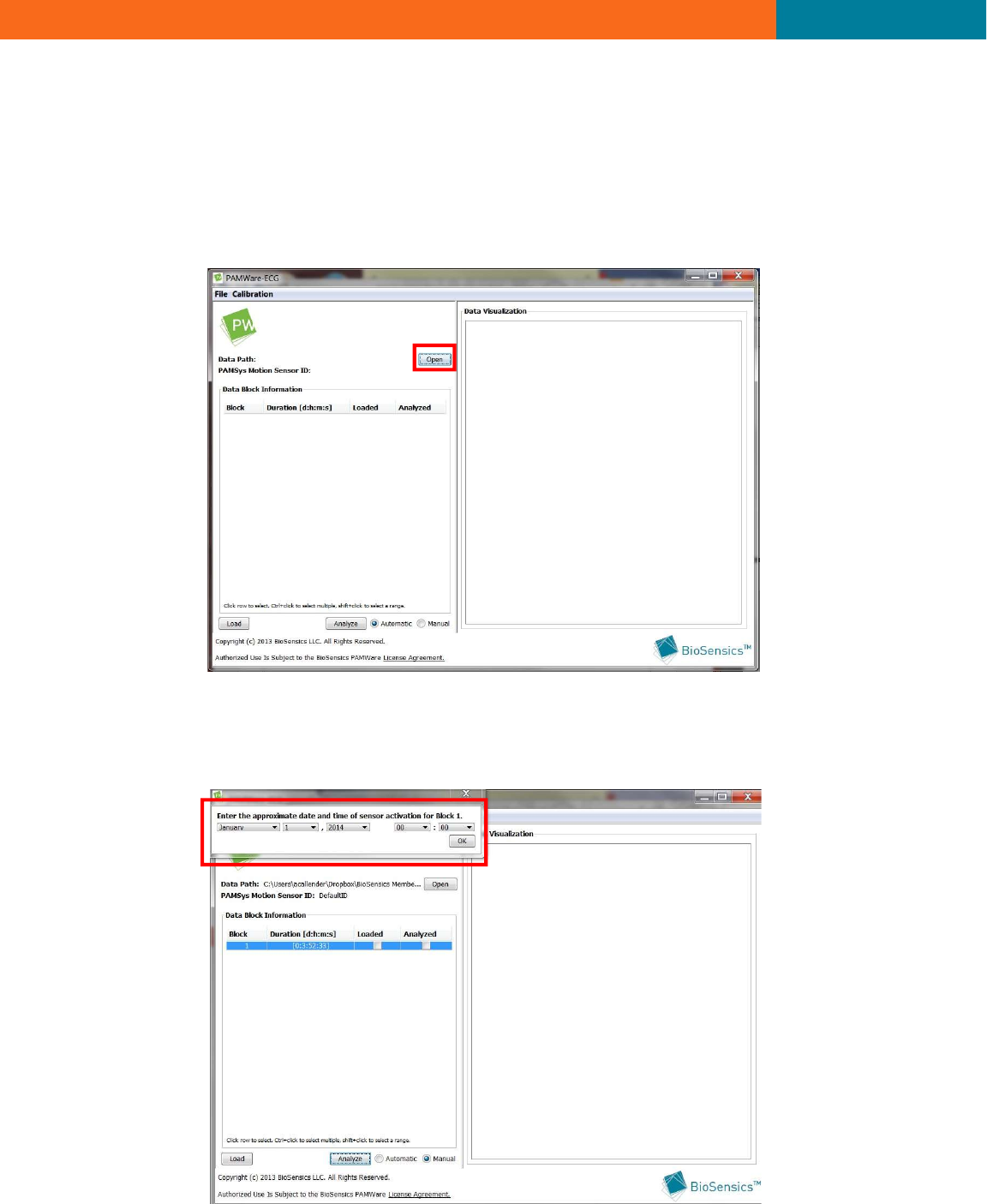
PAMSys User’s Manual V2.0
12
Data Analysis
Data Analysis
Loading Data
Run PAMWare to open and visualize data collected with your PAMSys motion sensor. Click the open
button to locate the subfolder for the data you want to load (e.g., ‘IDxxxx-Myyy’).
Next press the ‘Load’ button to load the raw data. A small window will appear to input the
approximate date and time when the measurement was started. The PAMSys sensor does not have
a clock; it only knows time elapsed from the start of each new measurement.
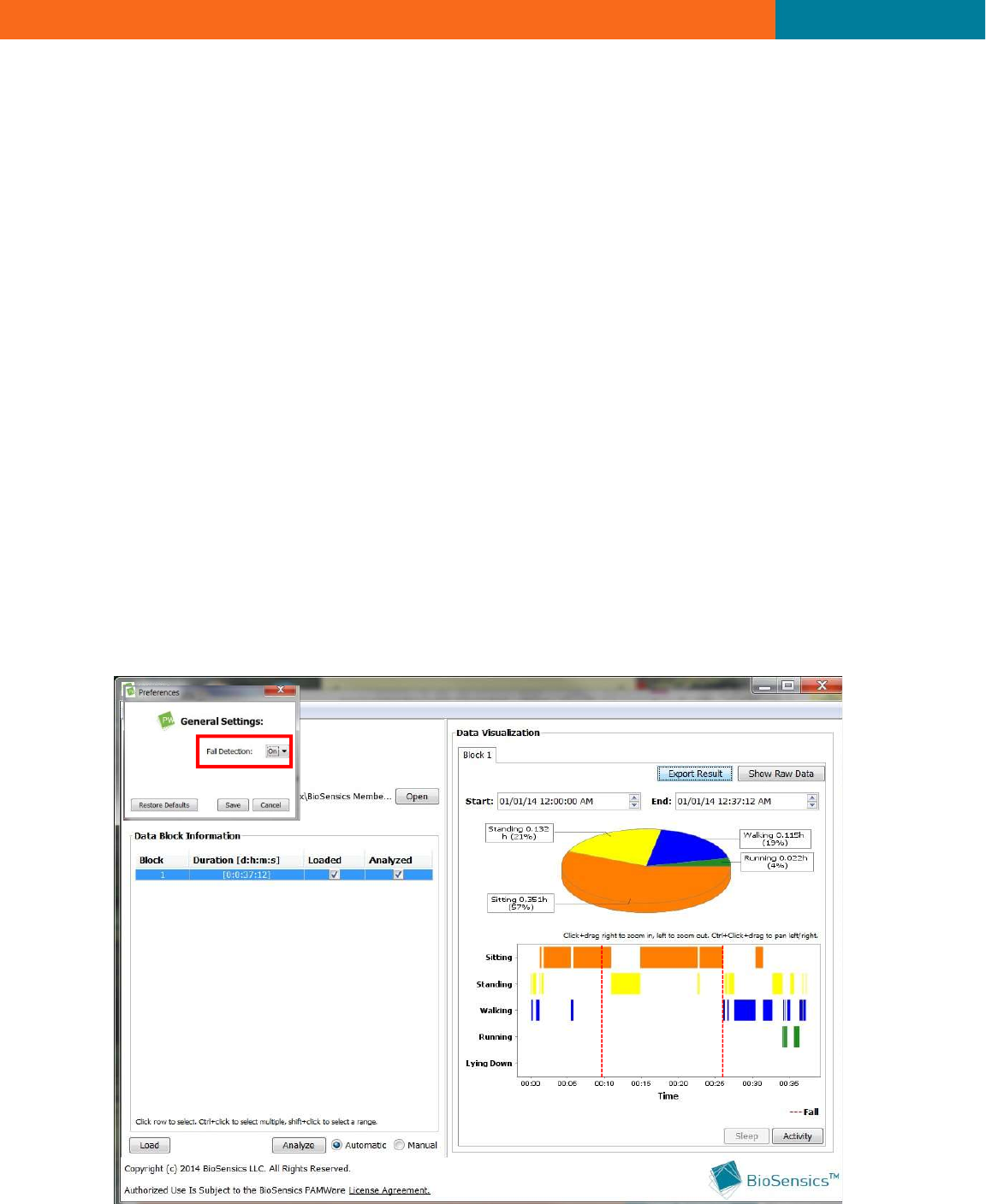
PAMSys User’s Manual V2.0
13
Data Analysis
Analyzing Data
To analyze the data properly PAMWare must know the orientation of the sensor and a start time
when the user was standing still and upright. PAMWare can detect sensor orientation and start time
automatically or you can input this information manually; select ‘Automatic’ or ‘Manual’ before clicking
the ‘Analyze’ button.
If ‘Manual’ is selected, a new window will appear where you can select the sensor orientation and
start time. The ‘Detect Orientation’ and ‘Detect Start Time’ buttons will perform these operation
automatically. Click the ‘Start Analysis’ button to begin analyzing your data.
Interpreting Analyzed Data
In the ‘Data Visualization’ pane, the raw data will now be categorized based on physical activity
(sitting, standing, walking, running or lying). Fall incidents can also be visualized by going to File ->
Preferences and choosing between ‘On’ and ‘Off’ from the dropdown menu. Fall events will appear on
the graph as dashed red lines.
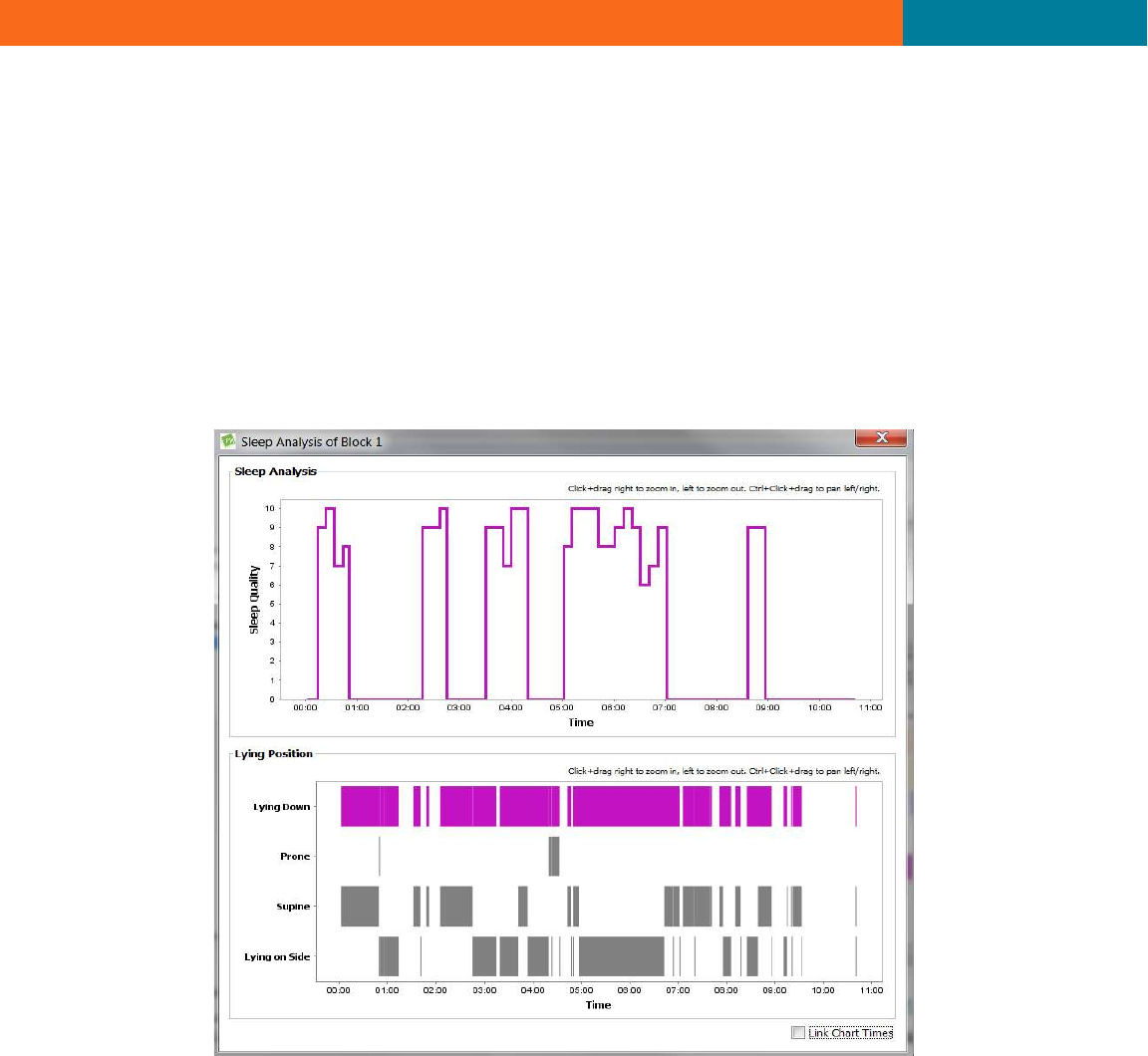
PAMSys User’s Manual V2.0
14
Data Analysis
Sleep
To view the analysis of lying data, including sleep quality and lying posture, click the ‘Sleep’ button at
the bottom of the ‘Data Visualization’ pane. A new ‘Sleep Analysis’ pane will appear with two
sections: (1) Sleep Analysis and (2) Lying Position. Sleep quality is determined by the amount of
movement, or restlessness, collected by the sensor during periods of sleep. The greater the number
reported, the better the quality of sleep. The ‘Link Chart Times’ box at the bottom right hand corner
can be checked to link the times in the two graphs so that zooming one graph will change the time
axis on both graphs.
Activity
To view the analysis of postural transitions, walking and running, and energy expenditure click the
‘Activity’ button at the bottom of the ‘Data Visualization’ pane. A new ‘Activity Analysis’ window will
appear with three main sections: (1) Postural Transitions, (2) Gait Analysis, and (3) Energy
Expenditure, which can be viewed as METS or Calories/hr.
The Postural Transition section presents the total number of transition events and the duration, in
seconds, of the 10th, 50th and 90th percentiles over the total number of postural transitions. The Gait
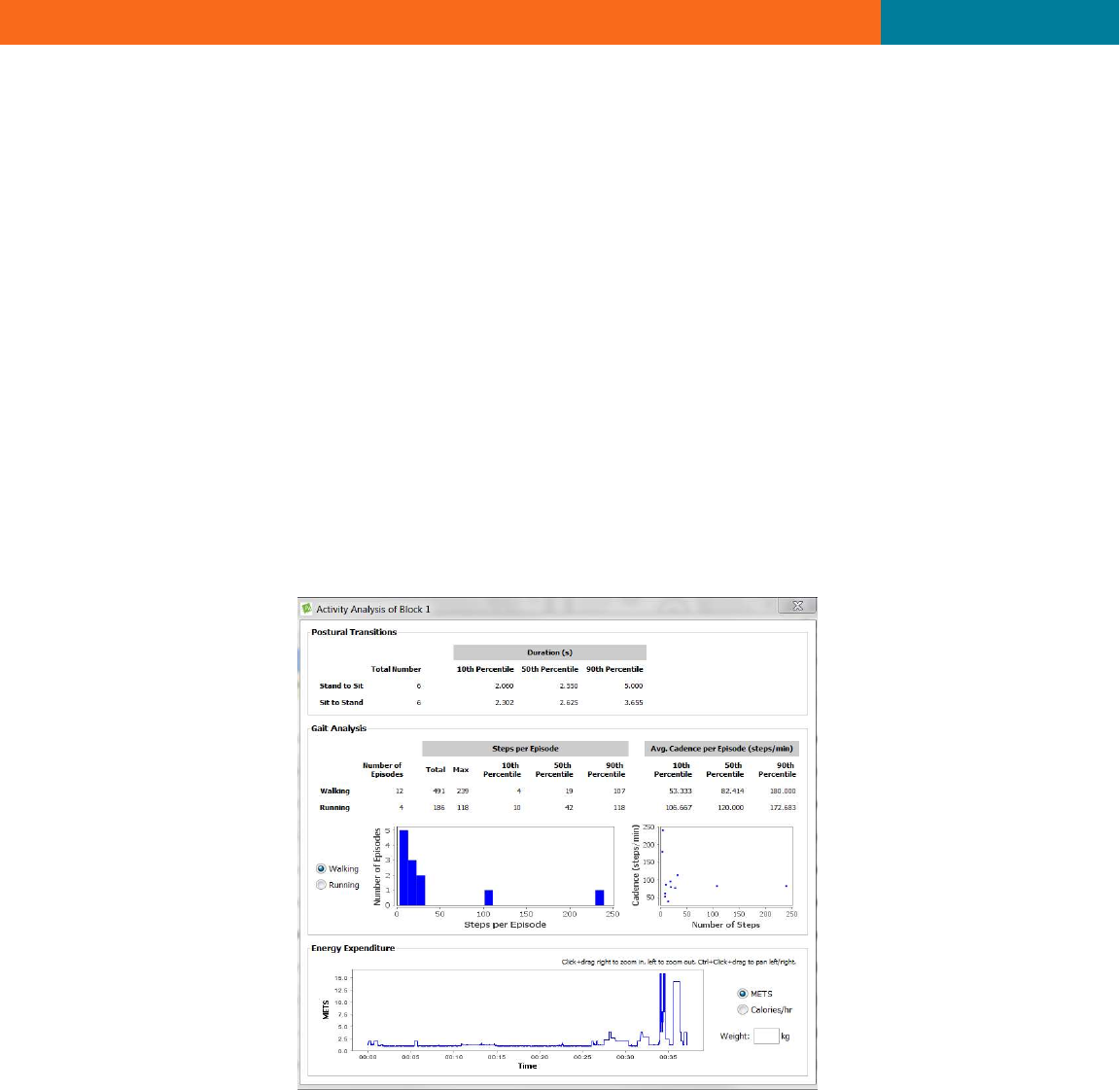
PAMSys User’s Manual V2.0
15
Data Analysis
Analysis section shows the number of walking and running episodes, the total number of steps
taken across all episodes and the maximum number of steps taken in an episode of walking and
running. Additionally 10th, 50th and 90th percentiles for steps taken and average cadence are
reported over all the episodes. You can switch between walking and running by clicking on the
‘Walking’ or ‘Running’ radio buttons. Energy Expenditure is displayed over the duration of the
monitoring period and can be visualized as METS or Calories/hr. A MET, or metabolic equivalent, is
a measure of the energy expended during physical activity expressed as a ratio of metabolic rate for
a given task to a reference metabolic rate during quiet sitting. One MET is equivalent to one Calorie
per kg body weight per hour. Note: 1 kcal = 1 Calorie = 1000 calories. Energy expenditure
calculations in PAMWare are based on movement intensities measured by the sensor and task
specific metabolic equivalents as reported in Compendium of Physical Activities: an update of
activity codes and MET intensities (Medicine and Science in Sports and Exercise, 2000; 32
(Suppl):S498-S516).
Exporting Data
Both analyzed and raw data can be exported. To export analyzed data to an excel file, click the
‘Export Result’ button at the top of the ‘Data Visualization’ pane. You can view the raw data at any
time by clicking the ‘Show Raw Data’ button at the top right-hand corner of this pane. To export the
raw data as DAT or CSV files, click the ‘Export Data’ button at the top of the ‘Data Visualization’ pane
when viewing Raw Data.

PAMSys User’s Manual V2.0
16
Specifications
Condition Specification
Waterproof rating IPX7
Sampling Frequency 50 Hz
Accelerometer
± 2g
Motion Sensor Size 3.5 cm x 3.5 cm x 1.5 cm
Motion Sensor Weight 24 grams (0.85 oz)
Storage Temperature -30 to 50 degrees C
Operating Temperature 10 to 40 degrees C
Battery Life 200 hours (upgradeable to 340 hours)
Bluetooth Radio Bluetooth v4.1, Class II, FCC ID: 2AA5HPM002
Certifications
ISO 13485:2016
FCC ID: 2AA5HPM002
IC ID: 22184-PM002
Specifications

PAMSys User’s Manual V2.0
17
Additional Resources and Support
Help and support are available from 9am to 5pm Monday through Friday (Eastern Standard Time).
Please contact us at:
E-mail: support@biosensics.com
Telephone: 1-888-589-6213
BioSensics, LLC
42 Pleasant St. Suite 2
Watertown, MA 02472
DISCLAIMER:
The PAMSys platform and algorithms for physical activity measurement are protected by U.S. Patent
No. 8,206,325, and other patents pending. PAMSys is neither offered, marketed nor intended for use
as a medical device, as defined by the Food and Drug Administration. PAMSys is intended and
marketed solely for use in research settings. Developed and designed by BioSensics in
Massachusetts.
© 2016, BioSensics LLC. PAMSysTM is a trademark of BioSensics. All rights reserved.
Information in this document is subject to change without notice
Support